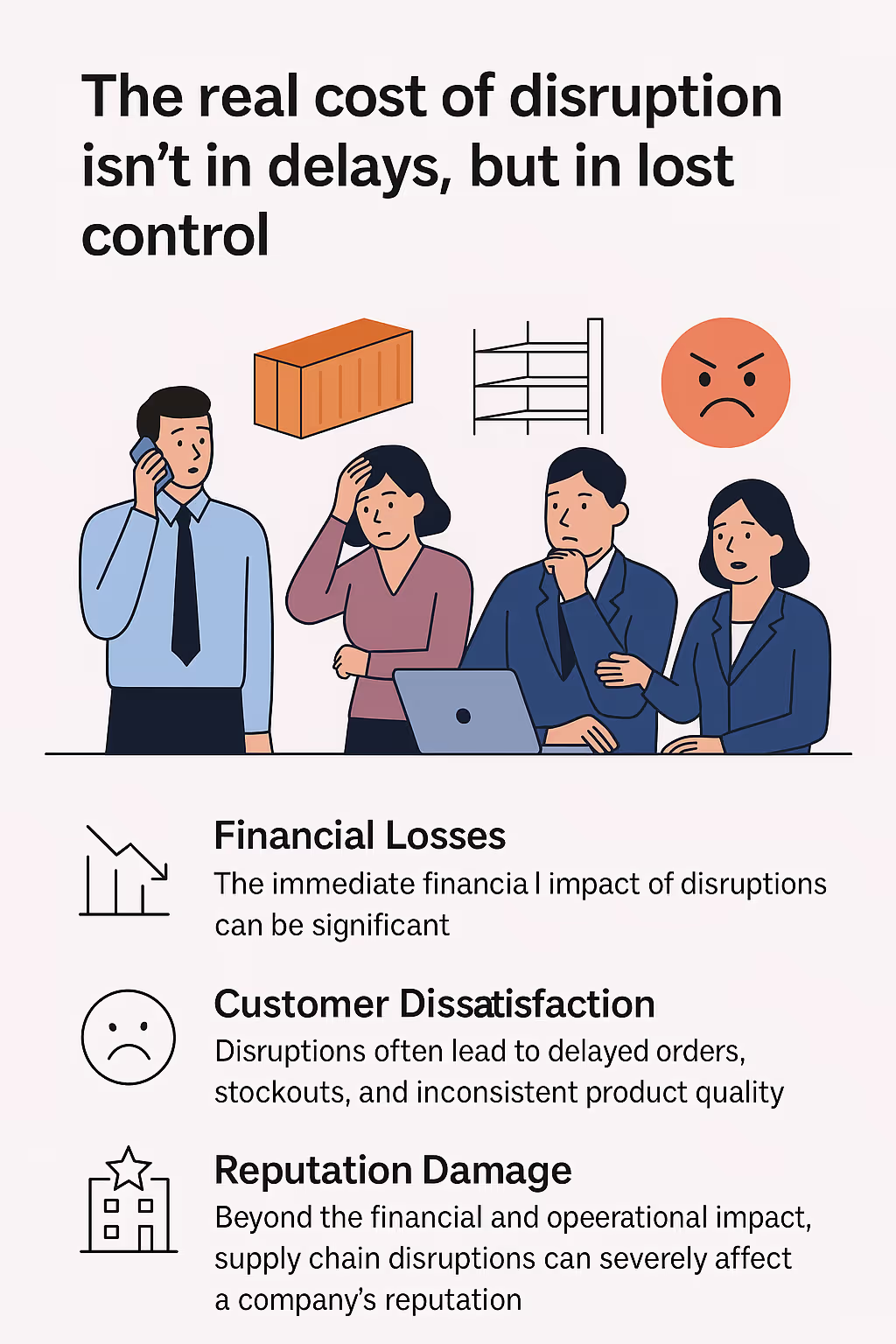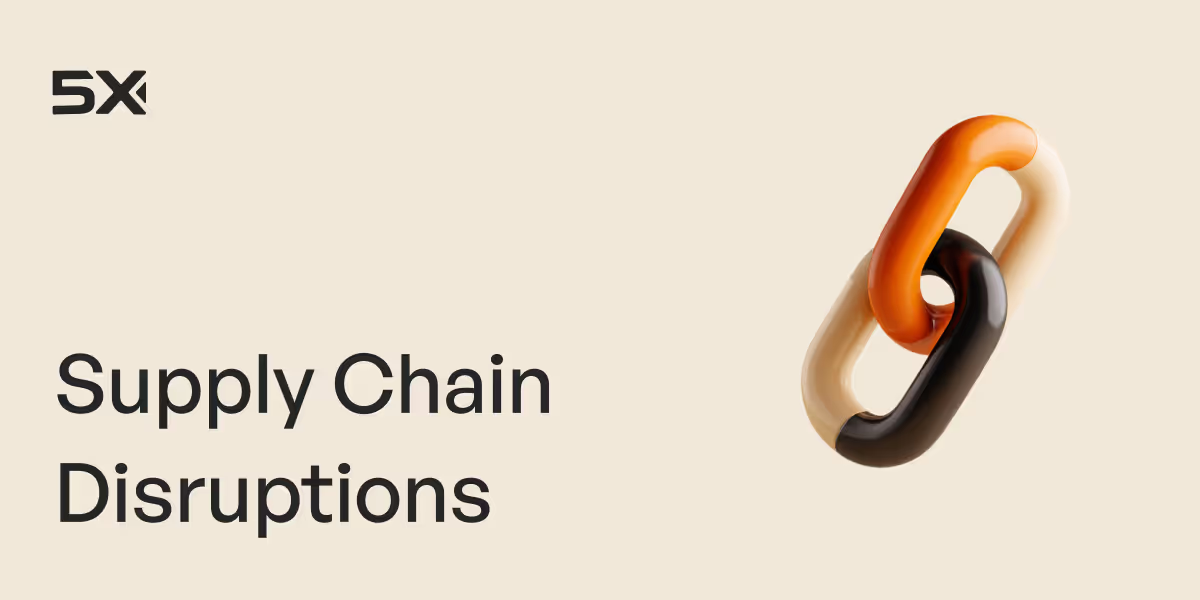Table of Contents
TL; DR
- Supply chains are under siege. Disruptions are frequent, costly, and intensifying with climate, cyber, and geopolitical risks driving the chaos
- Reactive ops are obsolete. Most companies still rely on siloed systems, lagging alerts, and spreadsheets — a recipe for missed revenue and reputational damage
- The ROI on prediction is real. AI-driven forecasting slashes errors by 50%, trims inventory, and reduces logistics costs by up to 20%
- 5X turns foresight into power. It connects 500+ data sources, delivers predictive models in 48 hours, and automates responses before problems snowball
- The winners will act early. Companies that unify their data, automate responses, and embrace predictive ops will crush those stuck reacting
It’s no longer a question of if your supply chain will break; it’s a matter of when and how hard. In the past few years businesses have been blindsided by freak snowstorms in Texas, cyberattacks against logistics providers in Singapore and flash floods that swept through German rivers.
Overnight, containers get stuck, parts vanish and suddenly your operations team is searching for answers they should have had days ago. The old playbook of scramble, react and recover doesn’t cut it anymore. Every crisis piles on costs, exposes fragile processes and leaves customers fuming.
Smart operators aren’t waiting for the next catastrophe; they’re predicting it. Using real‑time data, AI and a unified view of their supply chain, they spot weak signals, anticipate delays and course‑correct before the damage is done.
This post dives deep into the hard numbers behind today’s supply‑chain chaos, explains why reactive systems are failing and shows how predictive intelligence—especially platforms like 5X—turns disruption into competitive advantage.
We’ll also show how early adopters are already seeing fewer emergency shipments, lower buffer stocks and happier customers.
What exactly is a supply chain disruption, and why are they multiplying?
Any event that interrupts the flow of goods, services or information across your value chain qualifies as a disruption. External shocks include floods, port closures, geopolitical flashpoints, pandemics and cyber‑attacks.
Internal failures, from a supplier’s late delivery to a labour strike or a quality issue, can be equally damaging. Disruptions rarely stay isolated; a missing part delays production, which cascades into stock‑outs, rush shipments, overtime and unhappy customers.
How often does this happen?
Major supply‑chain disruptions lasting a month or more occur every 3.7 years on average, meaning long‑tail shocks are not freak accidents but part of the base case.
In 2024, 76 % of European shippers reported supply‑chain disruptions and nearly a quarter faced more than 20 incidents in a single year.
How big is the financial hit?
Disruptions are brutal. Large companies lose an average of $184 million per year because of supply‑chain disruptions. When disruptions stretch beyond 30 days, they can wipe out 3–5 % of EBITDA, and major incidents can erase 30–50 % of yearly earnings.
Why reactive systems fail

Most companies still rely on lagging indicators: a late‑shipment alert triggers after the damage is done; a supplier’s missed window shows up in a monthly report. By the time you see the problem, your options are limited. Several structural issues compound the problem:
- Fragmented data: Separate ERP, transportation management and vendor systems don’t talk to each other. A study of supply‑chain executives found 78 % maintain separate systems for inventory, ordering and logistics, creating data silos that undermine strategic decision‑making
- Lack of visibility: Only 6% of businesses claim full end‑to‑end visibility. This means most executives learn about delays when a container fails to clear customs or when a production line stops
- Delayed response: Traditional systems measure response time in days or weeks; AI‑driven systems react in minutes or hours
- Under‑utilised AI: While AI dominates the conversation, actual deployment lags. Only 1 % of companies have scaled AI across multiple functions, while 39 % are still researching and 25 % aren’t exploring AI at all. Meanwhile, those who have integrated AI across planning, execution and analytics see 2–3 times greater ROI than those with disconnected point solutions
As a result, companies are stuck in firefighting mode, burning through buffer stocks, paying for expedited freight and watching margins erode.
Also read: Top 10 Data Integration Tools in 2025 [Break Data Silos]
How predictive intelligence changes the supply chain game entirely
Predictive AI turns weak signals into actionable intelligence. It aggregates data from dozens of sources—supplier performance, shipment status, port congestion, weather patterns, commodity markets and even social media sentiment.
Machine‑learning models identify correlations and patterns that humans miss, then generate risk scores and early warnings. When the model predicts a delay, it automatically recommends a reroute, triggers a backup supplier or signals a stock‑level adjustment.
For example:
- A sudden change in a key supplier’s on-time rate triggers a risk alert
- Weather shifts in a transit zone prompt automatic rerouting
- A spike in raw material prices leads to forecasted margin erosion
When the model predicts a high probability of a delay or disruption, it can automatically recommend (or even initiate) a response: reroute a shipment, expedite from a backup supplier, adjust safety stock levels, or notify customers about a potential delay, all before the dominoes start falling.
How predictive AI works

- Data integration: Predictive AI integrates data from multiple sources, including supplier performance, market trends, weather patterns, and logistical metrics. This comprehensive approach provides a 360-degree view of potential risks
- Pattern recognition: By analyzing historical data, AI identifies patterns in disruptions, which can be due to weather, supplier performance, or market conditions. These insights help companies understand when and where disruptions are likely to occur
- Forecasting: Once patterns are recognized, AI uses these insights to predict the next supply chain disruption; ranging from supply shortages to transportation bottlenecks, allowing businesses to prepare ahead of time
- Real-time monitoring: AI constantly monitors supply chain signals, adjusting forecasts in real-time based on new data. This continuous analysis helps industries stay agile and responsive, even in the face of unexpected events.This is where 5X turns insight into action. Not to patch the chaos, but to prevent it entirely
Also read: How to Improve your Supply Chain Process using AI
Your roadmap to disruption‑proof supply chains
You don’t need a moonshot project or blank check to get started. Moving from reactive scrambling to proactive precision is a step-by-step journey. Here’s a structured roadmap:
1. Audit your blind spots
Start by identifying where your supply chain is most fragile or opaque. Where did you get burned in the last crisis? Supplier handoffs, port dependencies, single-sourced parts, antiquated systems; list the usual suspects.
Use a “root cause” mindset: dig into not just what broke, but why you didn’t see it coming. Often it’s because data was missing or siloed. This audit highlights where better visibility and predictive insight would have the biggest payoff.
2. Unify your data
You can’t predict what you can’t see. Bring together your internal systems (ERP, WMS, TMS, procurement, etc.) and relevant external signals (weather, market demand indices, logistics provider data) into one integrated platform.
Whether it’s a data lake or a specialized platform like 5X, the goal is a single version of truth. Without integration, there is no intelligence. This step also means cleaning data and establishing data governance—garbage in, garbage out.
3. Set up disruption predictors
Pick a couple of high-value use cases and build predictive models for them. Start small and iterate. For example, deploy an AI model to predict supplier delays based on their past performance and external risk factors, or a model to forecast demand more accurately for a volatile product line.
Focus on patterns in historical data and seasonality, then feed in live signals to adjust forecasts in real time. Don’t wait for perfect data, even a 60% accurate model is better than flying blind. Iterate fast, measure accuracy, and improve.
4. Automate responses
A prediction is only as good as the action it triggers. Define playbooks for your highest-risk scenarios. If a shipment delay is predicted, what’s the threshold to trigger a reroute or an expedite? If a supplier risk score goes red, do you have a backup supplier ready to go?
Use workflow automation tools (many modern supply-chain platforms have them, including 5X) to codify these responses. The idea is to empower the system to act when certain conditions are met, without waiting for a manager’s manual decision at 3 AM. Human override is always available, but automation buys you speed.
Also read: Robotic Process Automation (RPA) vs Intelligent Process
5. Track leading indicators
Finally, change what you measure. Most companies manage by lagging metrics: fill rate, on-time delivery, quarterly budget variance. To truly become proactive, start obsessing over leading indicators: supplier on-time trends, forecast accuracy, average response time to a risk alert, mean time between disruptions, etc.
Monitor how quickly you detect and resolve issues. Set targets for improvement. Continuous improvement depends on continuously measuring not just outcomes, but the early-warning signals and how effectively you respond to them.
Also read: 13 AI Use Cases in Supply Chains For Business Owners
5X turns scattered signals into predictive supply chain control
Most platforms tell you what went wrong. 5X tells you what’s about to. That’s because it connects to over 500+ data sources, including your supplier systems, logistics platforms, ERP, market feeds, weather forecasts, and more. Then it builds a unified business intelligence layer that flags disruption risks before they hit your operations. It comes with a semantic layer that reads into your business context and answers your questions in natural language.
What would have taken us a year, we achieved in weeks with 5X. Their all-in-one data platform and dedicated consultancy made all the difference.
~ Mark Webster, CTO, XAP
XAP Customer Story
What happens next:
- Disruption alerts before the storm. Real‑time risk scores flag shipments, suppliers or lanes that are likely to fail. If a key supplier’s on‑time rate drops or a cyclone threatens a port, your team knows days ahead
- Automated workflows. When risk scores cross thresholds, 5X reroutes shipments, triggers backup suppliers or adjusts safety stock — automatically
- Unified dashboards. Decision‑makers see a single source of truth. Historical pattern detection prevents repeat failures, while scenario simulations let you test strategies before you commit
- Rapid ROI. Clients report slashing emergency shipments, cutting inventory buffers and aligning sales, operations and finance around a single set of predictive insights
FAQs
Is supply chain disruption still happening in 2025?

How do I deal with disruption in the supply chain?

What is a forecast in the supply chain?

What will the future of the supply chain look like?

Building a data platform doesn’t have to be hectic. Spending over four months and 20% dev time just to set up your data platform is ridiculous. Make 5X your data partner with faster setups, lower upfront costs, and 0% dev time. Let your data engineering team focus on actioning insights, not building infrastructure ;)
Book a free consultationHere are some next steps you can take:
- Want to see it in action? Request a free demo.
- Want more guidance on using Preset via 5X? Explore our Help Docs.
- Ready to consolidate your data pipeline? Chat with us now.

How retail leaders unlock hidden profits and 10% margins
Retailers are sitting on untapped profit opportunities—through pricing, inventory, and procurement. Find out how to uncover these hidden gains in our free webinar.
Save your spot









%201.svg)

.png)
.png)






